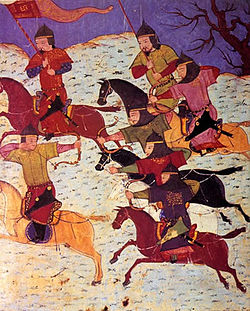Topic 2.2 The Mongol Empire and the Making of the Modern World
Revision as of 16:00, 29 November 2020 by Jhenderson (talk | contribs) (Created page with "::'''THE MONGOL KHANATES'''<BR> ::The Mongols built the largest land empire in the world, a remarkable feat considering they were pastoral nomads. Like the Muslims, Mongols ha...")
- THE MONGOL KHANATES
- The Mongols built the largest land empire in the world, a remarkable feat considering they were pastoral nomads. Like the Muslims, Mongols had to overcome deep tribal divisions before they could be integrated into a large empire. In the culture of the Central Asian steppes, loyalties of kinship were so strong that they prevented any broad cooperation between people of different bloodlines. Like the Bedouins of Arabia, Central Asia nomads seemed locked into constant tribal rivalries and warfare. Genghis Khan (1162-1227) was the man responsible for uniting these warring tribes into an empire. One of his tactics was to blur the lines between tribes by intermarriage. For example, after his defeat of the Tartars Genghis took two daughters of prominent Tartar aristocrats as his wives, and encouraged other Mongols to do the same.[1] He thus blended the Tartar bloodline with his own making tribal distinctions less relevant. So widespread was his practice of cross-contaminating tribal purity through marriage and fathering children across bloodlines that recent DNA research suggests that 16 million people today are descended from Genghis Khan.[2]
- A more important method of breaking tribal loyalties was through military organization. The most basic unit of the Mongol army was a unit of 10 men called an arban. To break the power of tribal identity, the men in each arban were purposely chosen from different bloodlines. They lived together, trained together, and fought together. In battle, members of an arban could never leave one of their own behind as missing or a captive. Seniority in the arban was determined by age, just as it was in tribes; indeed, the strong bonds of loyalty that formed among members of the arban rendered the military unit a surrogate for one's tribe, the identity of which became increasingly irrelevant.
- The organization of the arban was projected across the entire army in multiples of 10. A group of ten arbans formed an unit of 100 called a zagun, and ten of these formed mingan, or battalion, of one thousand troops; ten of these was a tumen of ten thousand soldiers. [3] Promotion up the ranks was based on loyalty and performance with no consideration of the prestige of one's tribe. Communication across the empire depended on a postal service made up of arrow messengers. These fast riders delivered communications between stations set up approximately 20 miles apart, at which point another rider would take the message to the next station until it reached its intended destination.[4]
- An efficient communication network was not the only thing that benefited from the Mongols' mastery of their horses. Their equestrian skills were most effective on the battle field. The Mongol army, which could travel up to 100 miles in a day, had a level of mobility unparalleled until modern times. [5] A Mongol soldier spent much of his day on his horse, trained on his horse, used it for food, and could deliver arrows with deadly accuracy from the horse.
- Genghis Khan's armies first united the Mongol people, then began to incorporate other Asian tribes and Turks into his empire. He imposed law, called the Yassa, which codified most aspects of politics and the daily life of the empire. This law granted religious toleration and protected trade. The breadth of the Empire encompassed the Silk Roads and trade began to flow again. The Mongols sacked Baghdad and ended the Islamic Caliphate. They destroyed the Seljuk Turks and paved the way for the rise of the Ottomans. They ruled Russia as a tributary state. After taking the Song Dynasty, Genghis Khan's grandson Kublai Khan established the Yuan Dynasty and ruled China directly. The Mongol Empire had a profound impact of the development of world history.
- THE MONGOL KHANATES
- ↑ Genghis Khan and the Making of the Modern World. (2004) Jack Weatherford, p. 51.
- ↑ http://news.nationalgeographic.com/news/2003/02/0214_030214_genghis.html
- ↑ Weatherford, p. 52.
- ↑ Weatherford, p. 72.
- ↑ http://www.mongolia-web.com/1203-mongol-military-tactics-and-organization#Mobility

